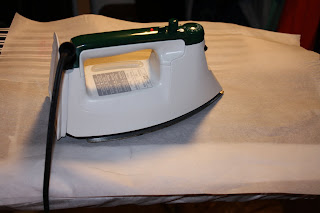I use a lot of interfacing when I make my bags. It takes some time to trace and cut-out all the pieces of interfacing and then fuse them onto my fabric. To save some steps I took advantage of the non-stick and heat resistance aspects of parchment paper. Now, I'm sure I'm not the first person to come up with this particular method I will describe in this post. However, I've searched and can't find a tutorial using this exact technique. I hope you find this useful.
In my early days of interfacing, I scoured the net for tutorials on all manner of application methods. I discovered many instances where parchment was used to protect one's iron and/or ironing board from the messy glue on fusible interfacing. It is extremely effective, easy to use, and cheap. I have been using the same sheet of parchment for over 4 months and haven't noticed any decline in effectiveness.
So, without further ado, let's begin this tute!
I begin by unrolling my interfacing (glue side facing up) across my ironing board. Next, I lay out my pieces of fabric (wrong side down) across the interfacing. I nudge everything up very close together so as not to waste any interfacing.
After I'm satisfied that all my fabric is wrinkle-free and wrong-side-down, I lay down my well-used sheet of parchment paper on top of the fabric. I take my hot, dry iron and slowly fuse the fabric to the interfacing. I am careful to make sure every piece is fused, but not overly concerned if some edges are loose because everything is getting ironed again on the reverse side later on.
You can see in the left picture above that my fabric is fused to the interfacing, the interfacing is still attached to the roll, and there is a big empty space of unused interfacing hanging off the edge of my ironing board. I still had more fabric to fuse, so I shifted the roll so the unused interfacing was sitting flat on my board and the fused fabric was hanging off the other side. Then, I fused on the rest of my fabric as you can see in the pic on the right.
Then, I flipped it all over and cut out the fused fabric. I saved the bigger and still usable pieces of interfacing ("waste not, . . . ") for another project.
So here are all my interfaced pieces of fabric. I ran an iron over the backsides once more for good measure, and decided everything is ready to sew! Now, that was easy wasn't it? No tracing involved. All my fabric was fused at one time. Very little interfacing was wasted.
I hope you found this little tute useful. Happy sewing!!















































